8 Reasons Why Your Gecko Bury Itself? [Crested and Leopard]
Have you found yourself with a trowel on your right hand and a dirty glove on your left ready to do some digging in your gecko’s tank? You might have felt the sudden gush of intense emotions the moment you discovered an empty tank. Just like any other pets, leopard and crested geckos may exhibit behaviors you do not understand. But why do they dig and bury themselves?
Leopard and crested geckos bury themselves under the ground for the following 8 reasons:
- inadequate light
- temperature problems
- humidity issues
- avoid stress
- shedding
- hunting
- laying eggs
- just for fun
Some of those reeasons require prompt intervention while others are no source of worries.
To know what to do in each occasion (and no worries, not always you should worry about), stay with us and keep on scrolling.
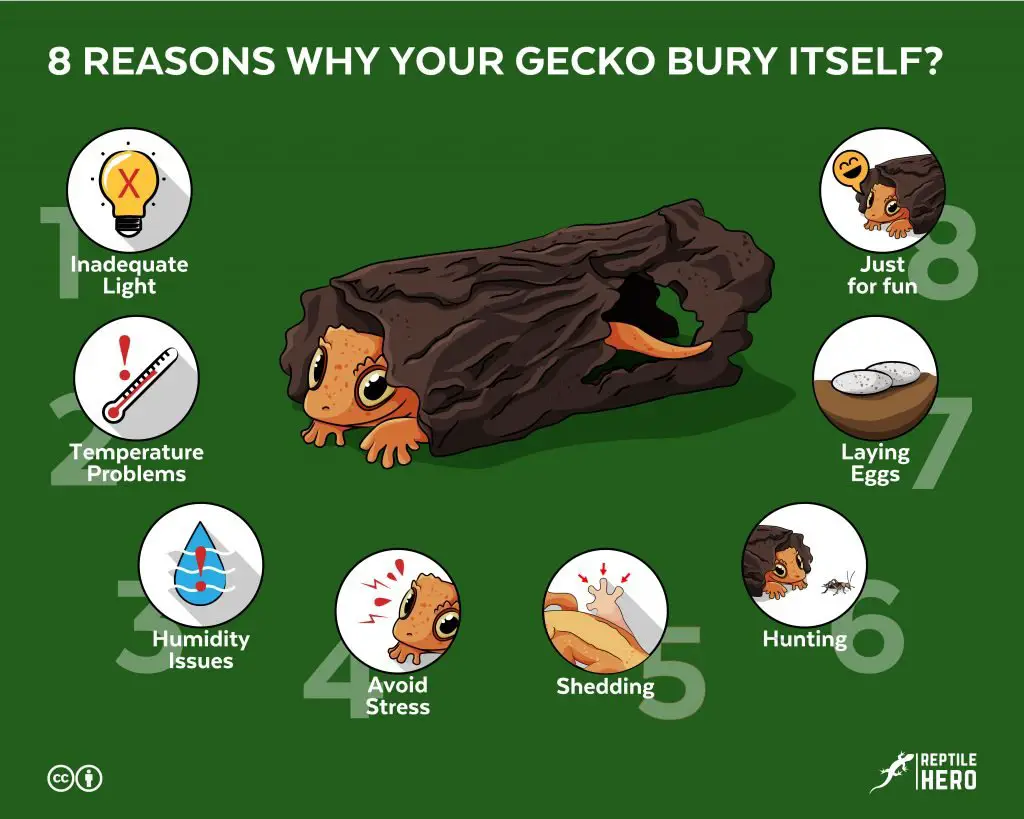
Why Do Leos and Cresties Dig?
With the lack of capability to speak like you, leopard and crested geckos have no exact way of expressing their vague behaviors in a way you could fully comprehend.
Thus, if you start to feel bothered by your reptile’s frequent burying and digging, you must consider looking into these eight reasons for the answer.
4 Reasons To Check Out
We will discuss in detail eight possible factors causing your gecko to bury itself under the substrate. Four of the reasons are rather urgent that you should immediately examine each of these to prevent unforeseen complications.
Light
You might have overlooked this trivial information: your leopard or crested gecko is most active when the sun sets until the sun rises.
Do you observe your pet burying itself during the day when the light is on? Then the lamp you are using for its tank may be disturbing your gecko and driving it underground.
However, nothing to fear should this be only happening during the day. You may think about your reptile’s act of digging as its countermeasure to find some shade and comfort in the substrate.
If its hides in the tank are inadequate, you must add more shelter to increase your gecko’s hiding places. You can make customized ones if you have time to spare.
Otherwise, you can purchase new ones like those great hides here on Amazon. These added accessories could prevent it from burying itself to avoid the flare by providing more dark areas.
In case it is not necessary to add more hides, you might also ponder on changing the daylight bulb you use in its tank.
The light you are using may be too harsh for your gecko. Reliable products on Amazon commonly preferred by owners like me include this.
Should these recommendations solve your issue, your gecko must come out more frequently and dig less to hide.
However, if you still notice that your reptile is shoving itself under the ground during the day and even at night, you must keep reading for other causes you need to examine.
Humidity
Though an arid tank environment with a low humidity level between 30% to 40% is not a concern for leos, this range may be a major issue for your crestie to stay under the ground.
When the humidity level in the tank nears 50% and drops even further unnoticed, this unpleasant circumstance would cause dehydration in your pet. Dehydrating your gecko is dangerous and could be lethal if it goes on for more than a couple of days.
Aside from this, having incorrect humidity levels would affect your gecko’s proper shedding. Incomplete shedding might happen, leading to loss of toes, tail tips, or, rarely, an entire foot.
As a response to the dry environment, your gecko would burrow underneath the substrate for a humid retreat. Hence, you should always keep the tank’s humidity in check.
By monitoring the hygrometer, you must ensure daytime humidity levels at 40-60% because your crestie requires a drop in humidity during this time. Besides, you must heavily mist every night to reach spike levels at 85-100%. For the rest of the night, you should maintain levels at 65-80% relative humidity.
During winter or in an arid environment, I recommend you heavily mist in the morning while replacing your current substrate with a more moisture-absorbent one such as peat.
If you have followed the suggestion yet are still facing the same problem, you should check its enclosure for possible leaks, causing failure to sustain the moist environment amid manual or automated misting.
Block all holes and crevices you can find to prevent moisture in the substrate from escaping the tank. Generally, if you use a screen sheet to cover your tank, you must replace this at once as it poorly keeps moisture.
Temperature
Just to remind you, crested geckos are very sensitive to temperatures below 68°F and above 75°F. Meanwhile, leopard geckos love the temperatures between 68 to 90°F.
However, burying itself sometimes signifies that your gecko feels too warm and tries to cool off under the substrate.
If you have opted for a bioactive tank, chances are you have indoor plants that do well in the shade; however, they may need UV bulbs reaching temperatures as high as 80°F.
While the warm temperature is essential for your plants to grow, your gecko may find it to be too hot since your pet is susceptible to heatstroke.
In return, you observe your reptile avoiding the heat lamp by burying itself under the ground for a colder environment.
To handle this, you might need to reorganize the tank to create a sufficient temperature gradient with a warm and a cool side. Adding supplemental moist hides on the cool side can help achieve cooler temperatures your gecko would love.
On a side note, I have noticed that my gecko only digs the soil and hides under the substrate during summer. Though I have implemented a temperature gradient in its tank, I did note high temperatures that are challenging to bring down.
To solve this seasonal behavior, I turn on the air-conditioning unit in the room. This method effectively lowered the ambient temperature of the tank.
However, you should be careful in setting the temperature of the unit. As you adjust the remote control, you must monitor the thermostat in the tank to avoid hitting lower than what is comfortable for your gecko.
On the other hand, your gecko may be hiding under the soil to warm itself from the cold environment.
When your gecko is full after a meal on a chilly evening, it might try to warm itself up by staying under the ground for heat.
Soils or sands as substrates are known to capture and store considerable heat during daytime when lights are on. With this, the warmth under the substrate may provide relief to your reptile.
If you do not like your pet to burrow itself at night, you can add a basking rock near the night lamp like this product I recently bought on Amazon.
Stress
Do you have a newly adopted or purchased leopard or crested gecko? Hiding under the substrate might help it feel secure with the new environment since relocating into another home is stressful for geckos.
If this is the case, you can only give your reptile some time to adjust and get accustomed to its tank. In more or less a week, you should be able to see it roaming around and exploring its surroundings more.
To reduce your fidgety pet’s stress, you can also add more accessory hides such as this cork bark I found on Amazon. Having this hide can aid your gecko’s adjustment period by introducing new secret spots above ground.
Apart from the reason above, burying itself under the substrate could be your gecko’s escape and defense mechanism from the presence of other reptiles if you have housed it with others.
Though crested geckos can tolerate minimal cohabitation, it is still best that you individually tank each of your reptiles to avoid stress and further unwanted problems like fights and injuries.
Do note, however, that this is not applicable to your leopard gecko because it should always be housed individually!
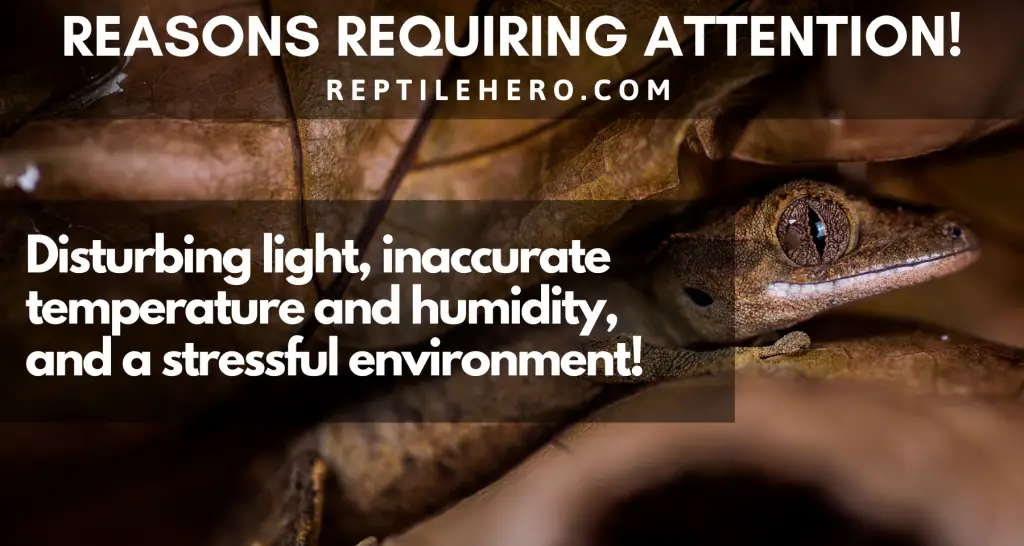
Other 4 Reasons
While the previous four possible causes focus on external factors such as tank maintenance, the last four reasons pertain to your leo or crestie and may not potentially pose adverse effects.
Shed Skin
One of my co-herpers noticed that his leos and cresties tend to bury themselves before shedding. Though he has not thought it through, this habit could be an empirical behavior of geckos to satisfy their healthy shedding’s moisture condition.
To prevent your reptile from digging underground during this period, he suggests that you supply a shed box above the ground so it does not use the substrate.
He emphasized that a 7-inch-long, a 4-inch-wide, and a 4-inch-tall box filled with a moistened, but not drenched, sphagnum moss would be most suitable to use.
As a result of the shed box, he commented that having that specific shed box inside the tank has massively reduced digging in all his geckos.
Moreover, he did warrant that your reptile would surely appreciate this humid soil-filled box to properly aid its shedding process.
Hunt Food
Do you feed your leo or crestie with live food inside its enclosure? It could be the reason why it is digging and burying itself under the substrate. Just like imitating its instinct in the wild, your gecko could be digging and hunting those escaped prey.
However, if you do not feed it with mealworms and insects, there could be any critters in the substrate itself—including worms, isopods, and springtails—that it could sense, therefore, searching for those.
If you are bothered by this not uncommon behavior, you can inspect the substrate for leftover live foods you fed it. A more exhausting option would be to change the whole substrate to ensure that there would be no live critters in it.
Lay Eggs
Unless you are confident that your leo or crestie is a female that has never cohabitated with a male, burying herself could indicate that your gecko is preparing to lay her unfertilized eggs.
Two to three days before she deposits her eggs, you might already see her burrowing into the substrate. If you measure the dug hole, it would be two to six inches below the top layer. She could spend and stay in the spot for a couple of hours laying the eggs.
On the other hand, if you have bred her with a male, your gecko could be gravid with fertilized eggs. That is why she is burying herself.
Take notice that she might bury herself for a week or so prior to laying her eggs.
Hence, you should pay close attention to her. Regularly check for hidden eggs in the morning. Also, do not allow the substrate to completely dry out so she could lay her eggs on moist soil.
However, whether you anticipate an impregnate egg or not, I recommend you slightly alter the tank’s setup.
What I do is provide a lay box and add real plants to my tank. I place the plants in pots with most of the substrates covered by smooth rocks to fend my gecko off from digging in the wrong spot. Meanwhile, you can make the lay box similar to the shed box above.
Having it this way, she would lay on a lay box and not under the dirt. This condition could make things a lot easier for you as well. Otherwise, looking for the eggs would be tedious because you need to dig around the tank.
No Obvious Reason
Unless your leo or crestie is a gravid female or all the reasons mentioned above do not apply to your situation, then your gecko may just seem to do it as a personal preference, and you should not be concerned about anything.
I have heard some healthy geckos burrow for no apparent reason. As you can find them usually in forest floors or rocky deserts in the wild, they may feel enclosed when digging and burying themselves, like naturally wedged in a cave or between leaves.
Moreover, other owners have expressed to me that their healthy geckos love to sleep exclusively underneath leaves and moss even though they have a variety of hiding places above ground.
On the other hand, others also prefer to stay out in the open atop rocks and branches.
In case your leo or crestie digs and buries itself along with distress and signs of illnesses, you should immediately see your veterinarian for a professional assessment.
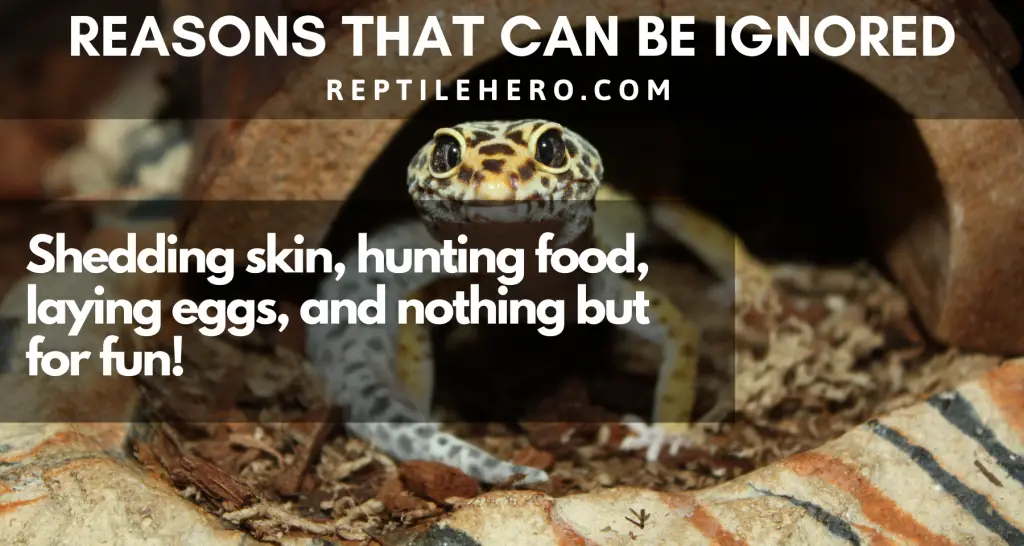
3 Quick Checks On Your Gecko [You Can Do Now]
Initially, most leopard and crested gecko owners like me think that females are the only diggers. However, over time, the pooled data show such action is indiscriminate. Despite having considered burying itself as normal behavior, you must still be vigilant when your gecko does this and always do the following:
Check Its Mouth
In case you observe your gecko attempting to eat the substrate, this signifies it needs more water and is trying to acquire it from the soil or sand. However, by doing so, it could only further dehydration. Worst case scenario is an impaction that could be fatal. Promptly prevent it from burying itself.
Examine Its Poop
The presence of sand or soil in your gecko’s poop means it has already eaten the substrate. This circumstance could potentially risk your gecko for a lethal impaction. The best way to prevent your reptile from having soil-y poop is to prevent it from burying itself in the first place.
Inspect Its Vent
The vent of your gecko is a sensitive area. Thus, it must be kept clean as much as possible. There may be times when your pet exposes its vent, like when straining to defecate. Therefore, being buried under the substrate could make the area vulnerable to infection. Be sure to prevent it from staying underground as much as possible.
Takeaways
Leopard and crested geckos bury themselves under the substrate when feeling discomforts from light, seeking to regulate temperature and humidity, and avoiding stress.
Burying themselves is also linked to other typical leopard and crested gecko behaviors like shedding skin, hunting food, and laying eggs.
If the gecko seems healthy and perfectly fine, digging and burying itself could just be its preference for no apparent reason.
In spite of being generally noted, owners must warily check the gecko’s mouth, examine its poop, and inspect its vent for substrates that could sicken the reptile.


![Do Leopard Geckos Need Heat Mats? [Myth or Truth]](https://www.reptilehero.com/wp-content/uploads/2022/03/does-gecko-needs-heat-mats-cc-768x614.jpg)
![Does Your Gecko Remember You? [2 Owners’ Stories and Science]](https://www.reptilehero.com/wp-content/uploads/2021/06/Does-your-gecko-remember-you-infographic-768x614.jpg)
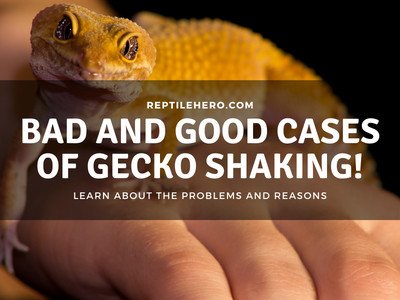
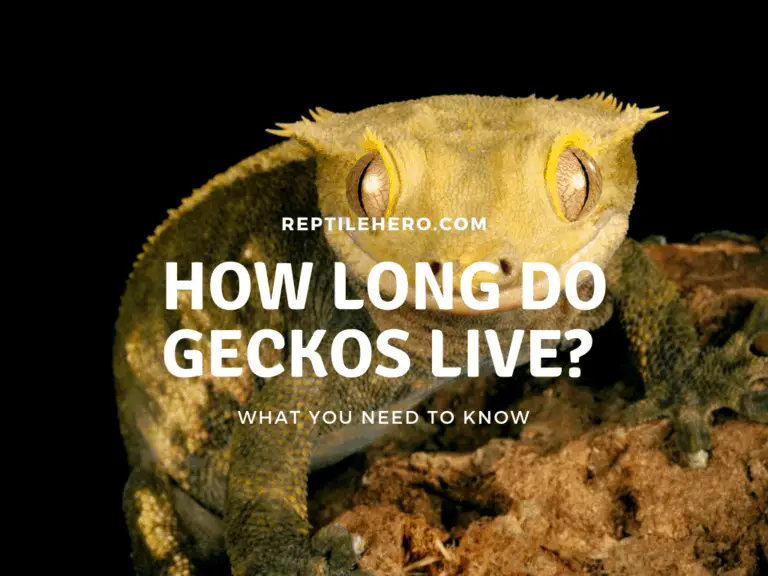
![Do Leopard Geckos Like Blankets? [Best Fabrics]](https://www.reptilehero.com/wp-content/uploads/2021/05/word-image-768x576.png)